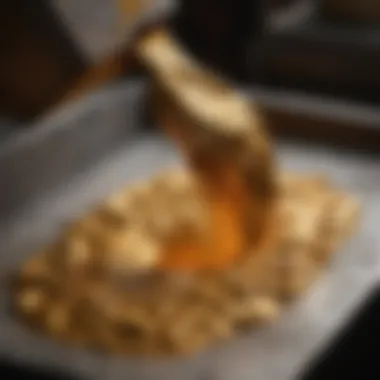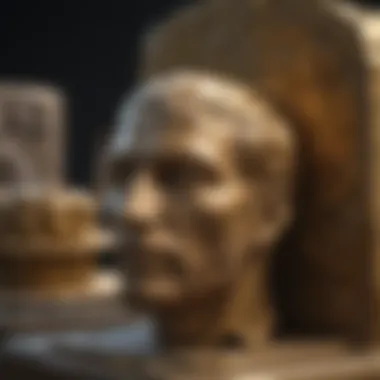Custom Gold Casting Molds: In-Depth Insights for Artisans


Intro
The realm of custom gold casting molds is rich and diverse, drawing interest from various fields such as jewelry creation and artistic sculpting. This article aims to uncover the layers of significance behind these molds, discussing crucial topics like material selection, the intricacies of the casting process, and how these elements ultimately affect the quality and innovative design of the final result.
Understanding the importance of custom gold casting molds can Áëally enhance an artisan's or collector's ability to produce and appreciate high-quality pieces. Today, we explore traditional methods as well as modern innovations, allowing the reader to gain insights that are both practical and inspirational.
The Integral Role of Custom Molds
Custom molds not only shape metal but also define the artistry involved in creating jewelry and artworks. These molds must be expertly constructed to achieve elaborate designs that differentiate a creation from the commonplace.
Why Design Matters
The design is pivotal in establishing the identity of the piece. Custom molds make it possible to execute unique designs that are tailored to individual visions or brand identities. The advent of technology has introduced various tools that allow for both precision and creativity in mold making.
Adapting to advancements in technology, while keeping traditional techniques alive, has proven to be beneficial in enhancing the quality of custom gold molds.
Balancing Tradition and Modernity
Artists and jewelers today value the combination of classical crafting skills and contemporary methods. Whether traditional techniques involving clay or modern computer-aided designs, each process has its benefits. Collectors should consider both the weight of tradition and the advantages of new tools when appreciating custom gold casts.
Understanding Custom Gold Casting Molds
Importance in Art and Jewelry Making
Custom gold casting molds are essential tools in the art of jewelry making and sculpture. They allow artisans to create unique, intricate designs that reflect their vision. These molds give creators the chance to replicate their hand designs or modify them, pushing artistic boundaries. This customization contributes not just to aesthetics but also to personal expression. The usability and adaptability of these molds encourage crafters to innovate.
Benefits of Understanding This Topic
This article delves into the fundamental aspects of custom gold casting molds. A comprehensive understanding of these molds implies familiarity with design, the materials, and the methods involved.
- Navigating the Creation Process: Knowledge about different mold types leads to better choices in production.
- Material Insight: Understanding the qualities of materials used for casting allows for higher quality outcomes.
- Historical Perspective: Grasping the evolution of casting techniques enriches one’s understanding of modern practices.
The exploration serves as a stepping stone for both seasoned creators and newcomers alike, offering practical knowledge that enhances craft precision and creativity.
Definition and Overview
Custom gold casting molds are specifically crafted forms designed to shape molten gold into desired structures, such as jewelry and other decorative items. These molds can be classified into various types, every one offering unique characteristics and capabilities. Custom molds are designed based on the requirements of the artisan, ensuring conformity to particular standards of design and execution. Their versatility is crucial for translating creativity into physical forms.
The process begins with the master model, which is a prototype from which the mold is produced. This master can be made from numerous materials including wax or digital designs, facilitating an accurate representation for the final cast. Ultimately, the key goal remains to achieve high quality castings that accurately reflect a designer's vision, establishing a direct relationship between the moldmaking process and the crafted pieces’ integrity.
Historical Context
The history of casting molds stretches back thousands of years. Ancient civilizations utilized similar methods to create jewelry, funerary objects, and other significant artifacts. Notably, the technique of lost wax casting emerged around 5,000 years ago in Mesopotamia, a method still fundamental in jewelry making today.
Throughout history, craftspeople have evolved their techniques, advancing from rudimentary forms to intricate designs. Highlights include medieval Europe’s development of new metal alloys that improved casting quality and resilience. In the modern era, innovations in technology have led to more sophisticated mold-making methods, such as 3D printing. This melding of tradition with modernity ensures that custom gold casting remains relevant in contemporary design and artistry.
“Custom molds embody the intersection of art and technology, allowing artisans to produce works that resonate with historical significance while pushing the boundaries of design.”
Importance in Jewelry Design
Custom gold casting molds play a critical role in the field of jewelry design. These molds allow artisans to explore their creativity by producing unique, high-quality pieces tailored to specific tastes and styles. The significance of these molds lies not only in their aesthetic contributions but also in how they enhance the technical processes involved in jewelry making.
Crafting Unique Pieces
In the past, jewelers often relied on mass-produced molds that limited their design options. However, custom gold casting molds provide a solution. They enable artists to translate their distinct ideas into tangible forms, ensuring that each piece of jewelry crafted is one-of-a-kind. The ability to create personal models means these molds can reflect individual styles, behaviors, or even the stories behind each design.
A few key advantages of crafting unique pieces with custom molds include:
- Personalization: Customers increasingly seek personalized experiences. Custom molds meet this demand by allowing unique designs to thrive.
- Innovation: Artists can experiment with new techniques or concepts without constraints, creating items that could not be replicated otherwise.
- Market Differentiation: In a competitive jewelry market, unique pieces can draw attention and build a deeper connection to consumers who values authenticity.
Moreover, the flexibility inherent to custom molds makes room for various materials and finishes. Artisans can add gemstones, choose different metal tones, or finish jewelry with specific textures, effectively differentiating complex ideas.
Enhancing Artistic Expression
Custom gold casting molds provide a canvas for artistic expression that transcends traditional constraints. They offer skilled artisans the freedom to play with forms, sizes, and aesthetics that would not be possible with standard molds. These molds bridge the gap between artistic design and production practicality.


Considerations in this domain can include:
- Complex Shapes: Intricately designed pieces can be created, inviting stakeholders to experience intricate details.
- Symbolism in Design: Artists can embed personal or cultural meanings into the design, hence adding emotional or traditional depth to gold pieces.
- Collaborative Projects: Joint endeavors with numerous artists become feasible. The shared process encourages diverse inputs and results in multifaceted designs that frequently surprise the marketplace.
Types of Custom Gold Casting Molds
Understanding different types of custom gold casting molds is essential for achieving desirable outcomes in both jewelry design and other applications. Each type comes with distinct properties that affect the final casting, including texture, detail reproduction, and durability.
Silicone Molds
Silicone molds are popular in the custom casting work due to their flexibility and ease of use. These molds can capture fine detail, making them ideal for intricate jewelry designs. The elasticity of silicone allows it to easily withstand the pressures involved in the casting process. Key advantages include:
- Detail Precision: Silicone molds can replicate even the tiniest features of the original model.
- Reusability: With proper care, silicone molds endure multiple uses, making them cost-effective over time.
- Simple Release: Their inherent non-stick properties simplify the removal of cast items.
However, it is important to consider the omgeving in which the mold operates. The curing temperature must be carefully controlled. Otherwise, molds may warp or lose shape. In addition, resistence to thermal stress must be evaluated to ensure consistent results.
Metal Molds
Metal molds are indeed more rigid than their silicone counterparts. These molds are often used for high-volume productions. They are durable and long-lasting, able to withstand extreme heat. Their key characteristics include:
- Durability: Metal molds last longer compared to silicone, especially under repeated heating cycles.
- Fast Production: Metal molds facilitate quicker cooling times, which reduces overall production duration.
- Robust Structure: Due to their sturdiness, they often create parts with sharp, clear lines, providing a maintainable aesthetic quality in jewelry.
On the downfall, they typically require a higher upfront investment and more complex fabrication methods. Moreover, adjustments, if needed, are tougher compared to softer molds. Detailed initial design is crucial.
3D Printed Molds
3D printed molds represent a modern technology that is transforming the custom casting landscape. This method allows for rapid prototyping and facilitates intricate designs that were previously challenging to achieve. Notable benefits include:
- Innovation: Facilitates the creation of unique designs with great ease. Complex geometries become practical.
- Customization: Each mold can be tailored to specific needs quickly, suited for one-off or niche work batches.
- Lower Material Wastage: Printing on-demand reduces input waste compared to traditional molding methods.
It is worth noting that the material used for printing needs to be very suitable for heat applications, or manufacturing might fail. Thus, careful selection of 3D printing materials must align with the intended use and application to ensure successful casting outcomes.
Considering the unique attributes of each type of custom gold casting mold is crucial for achieving effective and efficient results.
Materials Used in Mold Creation
The materials employed in custom gold casting molds profoundly impact the quality and versatility of the final creations. They determine the mold's durability, heat resistance, and detail reproduction, which are crucial factors for artisans looking to craft intricate designs. Different materials offer unique properties that have individual benefits and considerations. Understanding these elements is vital for anyone engaged in the casting process, as it directly relates to the success and precision of the work presented.
Types of Rubber and Silicone
Rubber and silicone are among the most prominent materials used in making flexible molds. They allow for easy removal of cast items, which is essential when delicate designs or multiple positive shapes are involved.
- Rubber Molds: They provide exceptional resilience and retention of detail. Rubber molds can withstand various casting temperatures, which is crucial in the gold casting process. However, they may not endure high temperatures as effectively as some of their counterparts.
- Silicone Molds: Silicone offers a broader range of flexibility and temperature resistance. This material is favored for its ability to capture minute details and provide a smooth surface finish. Additionally, silicone molds typically require less release agent, thus lowering the ecological footprint associated with the casting process.
In many cases, the choice between rubber and silicone depends on the design demands of the casting project, budget constraints, and overall desired outcomes.
Metal Alloys
When considering mold creation, metal alloys also play a critical role, especially in investment casting techniques and forging processes. Metals used in mold fabrication typically possess high melting points and robust structural integrity. Preferred metal alloys include stainless steel and aluminum.
- Stainless Steel: Known for its strength and resistance to corrosion, stainless steel molds can produce highly detailed castings and withstand prolonged use. This longevity translates into cost-effectiveness over time, despite the higher initial investment.
- Aluminum: Offering a favorable strength-to-weight ratio, aluminum is often used for intricate designs. It heats quickly and allows for exceptional detail reproduction, making it suitable for specialized applications despite the risk of deformation under excessive heat circumstances.
Choosing the right material requires a discerning evaluation of project requirements. For artisans hoping to create pieces that exhibit precision and durability, understanding these materials' traits ensures the renderings' accuracy in the finished works.
The Process of Creating Custom Molds
Creating custom molds for gold casting is a meticulous endeavor. This section underscores the significance of the design and fabrication processes involved. Quality custom molds influence the success of casting endeavors, ensuring that the final gold piece reflects the intended design accurately. Therefore, careful planning and execution in this phase impact the quality, durability, and overall artistic flair of the finished product.
Designing the Master Model
The initial step in creating custom molds is designing the master model. The master model serves as the prototype from which the mold is made. It can be created using various materials like clay, wax, or even metal, depending on the specifics of the design required.
When designing the master model, precise measurements are necessary. This accuracy ensures that the subsequent mold captures every detail. Designers typically sketch out their ideas before moving into production. This stage benefits from a creative person's skill in interpreting the conceptual design into a tangible form.
Additionally, digital modeling has emerged as a popular method. Software tools allow designers to create intricate models with exact specifications. These digital representations can simplify the transfer to 3D printing for efficiency.
The foundation of a successful mold is a well-crafted master model. Overflowing with intricate details, it paves the way for a beautiful final gold piece.


Mold Fabrication Techniques
After the master model is complete, the next task is choosing an appropriate mold fabrication technique. The choice will depend on the material of the master model and the intricacies of the design. Common methods include silicone molding, which is notable for its flexibility, and metal molds, known for their durability. Each technique has distinct advantages and challenges.
- Silicone Molding:
- Metal Molds:
- 3D Printing:
- Offers high detail replication, which is essential for unique or complex designs.
- Molds made with silicone last long and can withstand multiple uses.
- They are more forgiving when removing castings than rigid materials.
- Provide increased durability and strength, making them ideal for mass production.
- They can be expensive but tend to excel in longevity and reuse compared to softer molds.
- Advancements in technology permit custom molds to be printed directly from digital files.
- This technique allows for remarkable precision and speed in the design-sharing processes.
Determining the right fabrication method is essential, as this can affect the pace of production and the integrity of the final cast object.
Techniques in Custom Gold Casting
Techniques in custom gold casting are critical for achieving the desired results in jewelry making and other artistic implementations. Each method possesses distinct advantages, impacting the overall precision of the casting, the intricacies involved in the design process, and the quality of the finished product. Understanding these techniques allows artisans to make informed decisions based on their project requirements and intended outcomes.
Lost Wax Casting
Lost wax casting, also known as investment casting, is a time-honored technique utilized to create detailed metal shapes. It commonly follows these key steps:
- A wax model of the desired item is crafted, capturing all intricate details.
- This model is then coated in a material known as investment; this hardens to preserve the shape of the original model after the wax is removed.
- The wax is melted away, leaving a cavity corresponding to the original design.
- Molten gold is poured into the cavity, bringing the initial wax design to fruition in a metallic form.
The beauty of lost wax casting lies in its ability to produce intricate designs that are difficult to achieve through other methods. Artisans can replicate textures and forms with finesse, yielding one-of-a-kind pieces highly valued in fine jewelry and art.
However, the technique requires a meticulous process, especially in model making and the handling of investment materials. Subtle errors during any of the crucial steps could lead to defects in the final casting. Thus, proficiency and attention to detail are vital. This method finds favor among those who demand a depth of craft unseen in mass-produced items.
Sand Casting
Sand casting serves as a foundational technique primarily applied for larger items requiring durability. This method integrates a simpler approach, making it accessible for many artisans and commercial operations alike. The general process includes the following:
- Creating a mold using sand mixed with a bonding agent to hold its shape upon drying.
- The molten gold is then poured into the created mold.
- After cooling, the sand mold is broken away, revealing the casted piece.
This casting technique allows for fast production cycles and is cost-effective, making it popular for industrial casting, sculptures, and ornamental objects. The surface details visible on sand-cast items can sometimes be less refined compared to those produced through lost wax methods. Therefore, exceptions in considerations are necessary based on desired aesthetics and structural qualities. Sand casting is also versatile with the usage of various materials which can suit other non-gold metals, broadening its application scope. Flexibility in creating multiple pieces simultaneously caters significantly to the needs of larger productions.
Expertise in choosing the right casting technique is essential; each method reveals prices and possibilities that impact artistic intention and economic feasibility.
In summary, both lost wax and sand casting techniques are vital in the realm of custom gold casting, each presenting unique benefits and challenges. Their use highly depends on the project parameters. Understanding these techniques will serve artisans well in aligning their methodology with their thoughtful design vision.
Quality Control and Final Product Analysis
Quality control and final product analysis are essential elements in the creation of custom gold casting molds. These processes ensure that the molds serve their intended purpose while maintaining the integrity of the gold casting process. A consistent approach to quality control minimizes errors and enhances the final outcome, relentless improvement in craftsmanship. By assessing both the molds and the finished products, artisans can guarantee that they meet high standards for quality, precision, and artistic expression.
Assessing Mold Integrity
Assessing mold integrity is a crucial part of the quality control process. This involves checking for imperfections that could affect the final casting. Common issues include air bubbles, uneven surfaces, and misalignments, all of which compromise functionality.
Benefits of Mold Integrity Assessment:
- Ensures precision: Molds must accurately replicate the master model. Any flaws can lead to discrepancies in the final product.
- Prevents material wastage: Identifying flaws early save precious materials, preventing costs from mounting over time.
- Reduces rework: By ensuring high standards from the start, the need for costly replating or restyling diminish.
Implementing a methodical inspection routine, including visual checks and technical measurements, can highlight critical concerns. A well-maintained mold ultimately leads to consistently high-quality gold castings.
Evaluating Finished Castings
Evaluating finished castings is the subsequent step in the quality assurance process. This involves scrutinizing each piece to ensure it aligns with the original design specifications and quality expectations.
Aspects to Consider During Evaluation:
- Surface Finish: Look for rough patches or irregularities.
- Dimensions: Compare the casting with original designs to verify size and detailed specifications.
- Quality of Detail: Ensure that every intricate part of the design is accurately represented.
The post-casting analysis affects the final aesthetic appeal and functional capacity of the finished product. A meticulous approach not only affirms the quality of the work but enhances the artistic merit and genuine value of the gold casting.
"Quality control models provide a framework that elevates the quality of artistry and craftsmanship. Investing in these processes is essential for serious collectors and artisans alike."
The commitment to quality control banners a pathway for success in the dynamic realm of custom gold casting, making it imperative for those involved in this field. Continuous improvement in these areas benefits the producer and increases the trust and satisfaction of collectors and customers alike.


Applications Beyond Jewelry
The realm of custom gold casting molds extends well beyond the scope of mere jewelry design. This comprehensive exploration reveals the diverse applications of these molds, showcasing their significance in various industries. Understanding this versatility anMichael Malone be beneficial for artisans, manufacturers, and collectors alike. The adaptability of custom gold casting molds can unlock new creative avenues and innovative solutions in art, industrial sectors, and more.
Art and Sculpture
In the world of visual arts, custom gold casting molds serve as both practical tools and sources of inspiration. Artists successfully use these molds to create intricate designs that enhance their artistic vision. The gold casting process facilitates reproduction and variation of artwork pieces, allowing artists to achieve consistency in their work. Moreover, creating multiple pieces from a single mold can be economically viable and efficient.
A notable point in this context is that many sculptors explore freeform initial designs with flexible materials like silicone or wax. These yield molds allow for more access with a complicated workflow.
Custom molds are not just about function; they signify innovation and personal expression within the artistic landscape.
Some specific benefits include:
- Buoyancy of creativity: Artists pair simplicity in mold manipulation with complex concepts, allowing full potential for creativity.
- Wide variety of materials: Using custom molds, artists are not limited to gold; they can alternate materials like bronze and metals, which opens more creative doors.
- Improved marketability: Distinctive artistic contributions using casting methods often attract a dedicated audience, garnering interest from collectors and enthusiasts.
Industrial Uses
In addition to the world of art, the use of custom gold casting molds has notable applications within various industries. Many businesses leverage the advantages presented by these molds to enhance production efficiency and product quality.
Many industries utilize custom gold casting in different ways, the most relevant being:
- Manufacturing Components: In fields such as aerospace or automotive industries, precision molding enables the creation of intricate components that meet high safety standards.
- Medical Devices: Custom molds assist in developing complex parts required in forming devices such as prosthetics, which greatly improves functionality and user comfort.
- Plumbing and Machinery: Businesses often create fixtures and internal components that require durability and reliability, which custom gold casting accommodates effectively.
- Consumer Products: Manufacturers in various sectors, including household items and electronics, rely on casting to produce well-defined shapes while using minimal material.
The inclusivity of these applications demonstrates how custom gold molds foster productive solutions across several fields, offering significant financial benefits by optimizing manufacturing workflows. Collectors interested in this area can find unique items or materials being used, merging a passion for craftsmanship with industrial strength and artistic individuality.
The Future of Custom Gold Casting
The landscape of custom gold casting molds is evolving rapidly. As technology progresses, both the methods of production and the materials used continue to advance. Understanding these changes is essential for artisans, collectors, and industry professionals who wish to stay ahead of trends. This section explores insights into how modern innovations promise to enhance quality and efficiency in custom gold casting.
Innovations in Technology
Recent technological advancements are reshaping the approach to custom molds. One example is the rise of 3D printing. This technique allows for precision and flexibility. Where artisan designers once had to rely on traditional fabrication methods, they now can create highly detailed models within hours. This speed not only shortens the product development timeline but also reduces material waste, a clear ethical incentive.
Computer-aided design (CAD) software is achieving accurate simulations of how different molds will work with gold pouring and setting. It provides CASTERS the ability to experiment with designs virtually before committing resources to physical molds. Such technology helps pinpoint areas for adjustments, enhancing overall product efficiency.
Other innovations such as laser sintering and prototyping allow for a deeper exploration of intricate designs. Both these approaches push the boundaries of conventional craftsmanship. Increased accessibility to these tools means that even those outside of established jewelry houses( get a better shot at intricate customizing.
"Adapting to technological advancements opens new avenues for creativity and sustainability in custom gold casting molds."
Sustainability in Casting Materials
As the awareness for environmental impact grows, with each new plastic bottle floating in oceans or hidden in landfills, sustainability also pressures the casting industry. A growing trend in the market is the investigation into eco-friendly materials. For instance, manufacturers are now exploring the use of recycled metals for casting. By repurposing precious metals, artisans drastically cut down on the need for new mineral extraction, ensuing lower environmental disturbances.
Additionally, new biodegradable mold materials are emerging as commendable alternatives to traditional casting substances. Items crafted in these molds can still offer competitive performance while allowing the casting industry to pivot from its standard materials towards more sustainable options.
Incorporating advanced titanium casting techniques that minimize emissions serves as another robust path for environmentally conscious gold casting practice. Researchers continue to push this selection forward, focusing on making lowest impact decisions in sourcing and operations, which ensures both commercial success and rightful social responsibility.
The future is bright with expanding sites and innovations awaiting exploration. Addressing both technological and ecological factors will define the trajectory of custom gold casting. Evolving methodologies in creation emphasize the three core pillars: quality, sustainability, and luxury customization, leading ideally to a holistic market transformation. Collectors and artisans alike have great reason to anticipate what this evolution might yield in the next generation of custom gold products.
Ending
The exploration of custom gold casting molds reveals much about their significance in both artistry and commerce. These molds serve not only as tools of functional design but also as mediums of creative expression, applied extensively in various industries from jewelry making to fine art. Understanding this topic underscores several critical considerations:
- Importance of Customization: The adaptability of molds to create unique designs speaks to their role in elevating individual artistic visions.
- Technological Advancements: Innovation in molding technology contributes significantly to quality and efficiency in production, enhancing the potential offerings for art and jewelry lovers alike.
- Sustainability Factors: The ongoing shift toward more sustainable practices reflects contemporary ethical standards, making the choice of materials and processes increasingly relevant.
"Custom molds encapsulate the marriage of creativity and precision, bridging the gap between art and industry in a unique synergy."
The ability to assess the overall quality and craftsmanship directly impacts the final products' marketability and relevance in today’s discerning environment. Thus, understanding the nuanced dynamics of custom gold casting molds offers valuable insights.
Recap of Key Points
- Mold Varieties: Different types of molds, such as silicone and metal, cater to various needs and preferences in design.
- Material Selection: The choice of materials influences durability and artistic fidelity, making it vital for creators.
- Processes Involved: Mastery of techniques like lost wax casting plays a crucial role in reputable craftsmanship.
- Analysis of Results: Rigorous quality control processes ensure the consistency and excellence of the final pieces.
By revisiting these core elements, one appreciates the intricate interplay between the manufacturing process and the artistic outcomes in custom gold casting molds.
The Ongoing Relevance of Custom Gold Casting Molds
The importance of custom gold casting molds is likely to persist as technology and artistry evolve. Their relevance goes beyond simple design; it encompasses:
- Cultural Integration: In art communities, molds facilitate the depiction of cultural stories and heritage.
- Market Demand: There is continually growing interest among collectors and consumers for bespoke items, negating the appeal of mass-produced pieces.
- Resource Resilience: The exploration of sustainable materials aligns with broader ecological dialogs in manufacturing, ensuring that custom molds adapt to consumers' evolving philosophies.
These factors demonstrate the custom gold casting mold's resilience as a cornerstone of creativity and integrity in various fields. With the trends shifting towards personalization and sustainability, understanding these molds ensures ongoing appreciation and valuation in contemporary practices.







